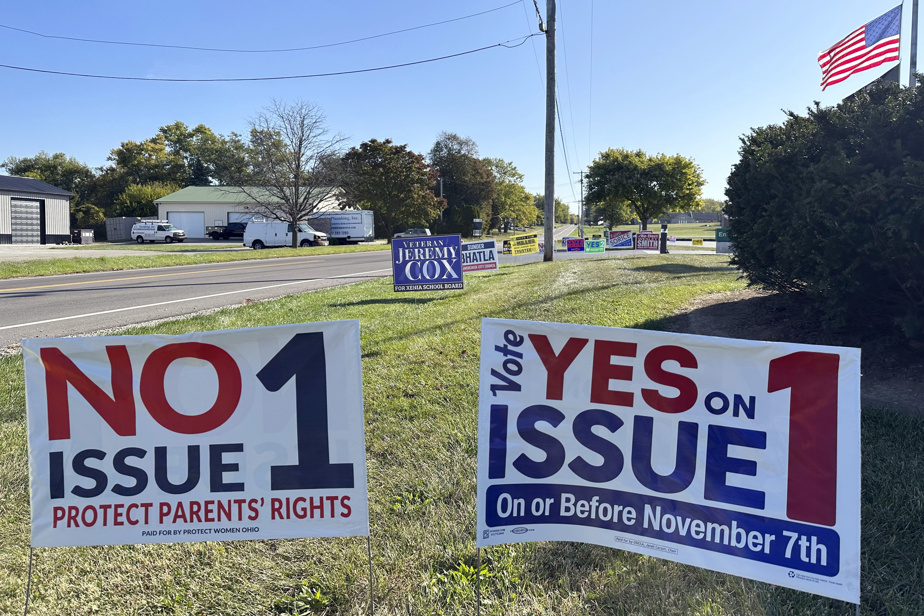(Columbus) The state of Ohio, in the American Midwest, is called upon to decide on Tuesday whether or not to include the right to abortion in its Constitution, a test vote which should allow both camps to adjust their national strategy on this central issue before the 2024 presidential election.
Pro-choice and anti-abortion groups mobilized across the state on Sunday to call on voters to vote before voting ends Tuesday evening.
“We will have people out today, Monday and Tuesday until the polls close, to call and knock on as many people’s doors as possible, to talk to every voter,” he told the ‘AFP Jaime Miracle, deputy director of the antiabortion association Pro Choice Ohio, on this sunny November day.

PHOTO MEGAN JELINGER, AGENCE FRANCE-PRESSE
Anti-abortion rally in Columbus, Ohio
Almost a year and a half ago, the United States Supreme Court, dominated by conservatives, overturned its “Roe v. Wade” ruling, which had guaranteed for half a century the federal right of American women to terminate their pregnancies.
The question therefore came back to the States. Several rushed to restrict or even ban abortion, others on the contrary strengthened its protection.
In Ohio, a law went into effect banning most abortions — even in cases of rape or incest — as soon as a heartbeat can be detected. That is to say around six weeks, often before a woman even knows she is pregnant.
This text is currently on hold due to a legal battle.
Pending a decision, it is still possible to have an abortion in Ohio up to approximately 22 weeks of pregnancy. But in the short time the ultra-restrictive law was in effect, a 10-year-old girl who was pregnant after rape had to travel to neighboring Indiana to have an abortion, a case that shocked the entire country.
Medical decisions
Voting closes Tuesday evening, but Ohio voters have been voting early for weeks already.
This involves saying “Yes” or “No” to an amendment to the local Constitution submitted by a pro-abortion citizen initiative. The latter provides that every person has “the right to make and implement their own decisions” in matters notably of abortion, contraception and treatment linked to fertility or miscarriages.

PHOTO CAROLYN KASTER, ASSOCIATED PRESS
Pro-choice camp demonstration in Cincinnati, November 2
The text specifies, however, that abortion can be prohibited once the fetus is considered viable outside the uterus. But such an abortion cannot be prohibited if the doctor judges that the life or health of the woman is in danger, continues the proposed amendment.
Several other votes on abortion ended last year in victory for the pro-choice camp, as in Kansas, to the great dismay and surprise of Republicans, who had to question their message.
The Ohio vote is therefore an opportunity for both camps to refine or reframe their strategy, with the 2024 presidential election in their sights.
Advocates for “Issue 1” — the name given to the amendment — focused their campaign on the need to prevent state interference in “personal medical” decisions.
And to give even more weight to this speech, the Ohioans United for Reproductive Rights coalition, in one of its advertisements, called on a religious figure.
“As a pastor, I have counseled families on the most important personal decisions, even abortion. Abortion is a private family decision. The state must stay out of family decision-making,” says Reverend Tim Ahrens.
Opponents of abortion, like the Protect Women Ohio coalition, call the amendment “extreme.”
“This is a radical proposal, and whether you’re pro-choice or pro-life, it goes way, way too far,” the state’s Republican governor, Mike DeWine, blasted Sunday on Fox News.

PHOTO MATT FREED, ASSOCIATED PRESS ARCHIVES
Ohio Republican Governor Mike DeWine
“It would enshrine in our Constitution the right to abort up to birth, therefore at any time during pregnancy,” he continued – an assertion denied by the opposing camp and denounced as disinformation.
The Ohio vote will be all the more closely followed as this state has long been considered a “swing state” – one of those crucial states because it oscillates between Democrats and Republicans and is likely to tip the scales – before carrying his choice twice in a row, in 2016 and 2020, over Donald Trump, again a candidate for 2024.
